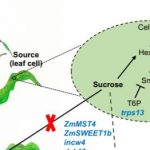Metabolome divergence during maize domestication
Xu et al. identify metabolites targeted by selection during maize domestication.
Plant Cell https://doi.org/10.1105/tpc.19.00111
By Guanghui Xu
State Key Laboratory of Plant Physiology and Biochemistry, National Maize Improvement Center, Key Laboratory of Biology and Genetic Improvement of Maize, Beijing Key Laboratory of Crop Genetic Improvement, Center for Crop Functional Genomics and Molecular Breeding, China Agricultural University, Beijing 100193, China
Background: Studies of domestication have focused almost exclusively on changes in morphology such as increased grain size, loss of shattering, larger inflorescences with more grain, and reduced branching. Yet, domestication certainly involved a much larger set of traits that have escaped analysis because they are not visible phenotypes. Among the traits that have gone largely unanalyzed are changes in the metabolic profiles of crops as compared to their progenitors. In this study, we sought to fill this void by analyzing metabolic evolution between maize and its progenitor, teosinte, which is the best-studied crop-progenitor system in the literature.
Question: In this study, we aimed to identify the metabolites that were targeted by selection during maize domestication and elucidate the underlying genetic basis. We achieved this goal by measuring metabolite abundance in the seedlings from diverse maize and teosinte accessions as well as from a maize-by-teosinte cross population.
Findings: We showed that a total of 461 metabolites exhibited significant divergence due to selection. Teosinte, tropical, and temperate maize, representing major stages of maize evolution, targeted distinct sets of metabolites. Alkaloids, terpenoids, and lipids were specifically targeted in the divergence between teosinte and tropical maize, while benzoxazinoids were specifically targeted in the divergence between tropical and temperate maize. Through integrating genome, transcriptome, and metabolome data from a maize-by-teosinte cross population, we identified candidate genes contributing to metabolic divergence, many of which were under selection at the nucleotide and transcript levels. Through overexpression or mutant analysis, we verified the roles of FHT1, Pr1, and ZmTPS1 in the divergence of their related biosynthesis pathways.
Next steps: Our evolutionary metabolomics study showed that the metabolome was reshaped during maize domestication and post-domestication adaptation. Further functional studies, such as experiments demonstrating the role of metabolites in biotic or abiotic resistance, are required to make direct connections between metabolite divergence and their ecological functions.
Guanghui Xu, Jingjing Cao, Xufeng Wang, Qiuyue Chen, Weiwei Jin, Zhen Li, and Feng Tian (2019). Evolutionary Metabolomics Identifies Substantial Metabolic Divergence between Maize and its Wild Ancestor, Teosinte. Plant Cell; DOI: https://doi.org/10.1105/tpc.19.00111
Key words: domestication; divergence; maize; metabolome




